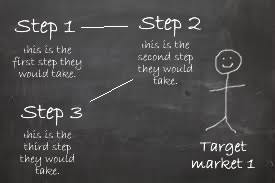Web Design Navigation Strategy in 3 Steps: #2 “Mapping”
Which of These Data Points is Just Like the Others …
In step one of your navigation strategy, data is gathered on your customers. The goal of that data pull is to understand what they experienced along their decision making journey and where the tipping points fell in your favor. In step two, your objectives are to organize and synthesize your findings from step one, and structure them into a useable format that can be applied to your web design.
To begin step two, look for consistencies, commonalities, and similarities in your target  market’s responses. Then compile, categorize and consolidate a list of recurring phrases from your research.
market’s responses. Then compile, categorize and consolidate a list of recurring phrases from your research.
Next, convert your findings into a flow diagram sequenced in order of your customer’s decision making process. This illustration will become a visual narrative. The story could be told with a something as crude as a series of symbols and stick figures on a chalkboard or notepad, or with something as elaborate as produced design from a graphic design program. The end goal is to create an easy-to-follow, but comprehensive “journey map” of the entire process to help solidify your understanding of your customer’s mindset and the strategy they follow when making a purchase.
From Data to Organized Steps
To convert your customer journey map into your website’s navigations, start by grouping common data points into “content clouds.” This approach will help you cluster all the information pertaining to each milestone in your prospective customer’s buying process. As an example, one cloud might be related to finding inspirations, followed by a closer look at the individual elements that make up each inspirational idea. Some major milestones will be comprised of distinct components, others will not. The major milestones will become your global navigations seen on every page of your website, and its components will represent the sub-navigations, or individual pages under each global navigation.
Using a “card sorting” technique, construct and confirm the validity and usefulness of your website’s navigations. This process can be done online or in-person using simple index cards. Since the essence of both are the same, let’s review the physical card sorting approach to convey the concept.
To initiate the transformation, take a handful of index cards, label each with what you used for the global navigations and sub-navigations identified thus far. Don’t worry about the exact verbiage you use for now because it will probably be tweaked based on the feedback received,. That said, try to be as specific with your verbiage as possible without obsessing over it to streamline your final naming process.
Next, arrange the global navigations across a row in sequence of the most common decision making process, from left to right. For any global navigations that have sub-navigations below them, place the most important sub-navigation on top, followed by the second most important, and so on.
In one eyeful, your index cards should summarize the buying process in sequence from left to right, and level of importance from top to bottom.
How Closely Does The Sales Process Align With The Buying Process?
After a navigational structure reflecting the buyer’s decision making process is established, a second and separate set of navigational structures are created to reflect milestones from a sales perspective. To put things into context and ensure everyone is on the same page, an ideal buyer should be identified and described. If there is more than one “archetype” of buyer, create more than one buyer persona.
Ask salespeople to play out a scenario for each buyer persona as though a past experience was described in hindsight. It is not uncommon to have different starting points for each persona with overlapping milestones across personas. The goal is to identify and chart out milestones of touch points between sales and potential customers.
Examples of milestones may include prequalifying questions and the flow of information conveyed by sales, or common questions and objections that surface from potential customers along the way. The goal is to determine if there are any places that your sales process gets in the way of your customers’ buying process and where they intersect.
The global navigations for sales should cover the time horizon from pre-sale, sale, and post-sale. Post-sales is critical because satisfied customers become extensions to your sales force when they contribute their testimonials and make recommendations. Pay close attention to any misalignment between delivery and expectations. These notes will help you further your insight into your customer’s needs during the buying process and allow you to refine your website design and navigation strategy to get as close as possible to the perfect buying experience for your site visitors.
The final step in the web navigation strategic process is internal research and finalization of the proposed website navigation. Check back for our next post to ensure you round out your website navigation with all the necessary criteria.
